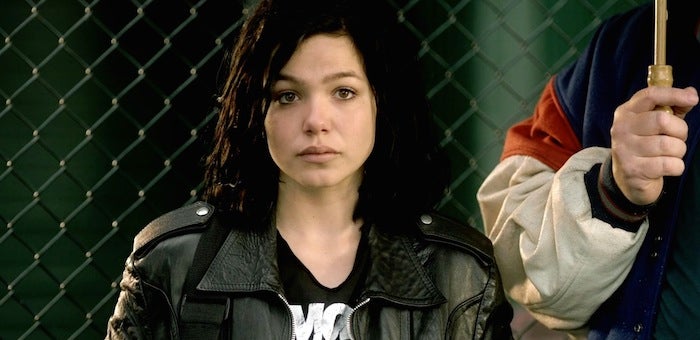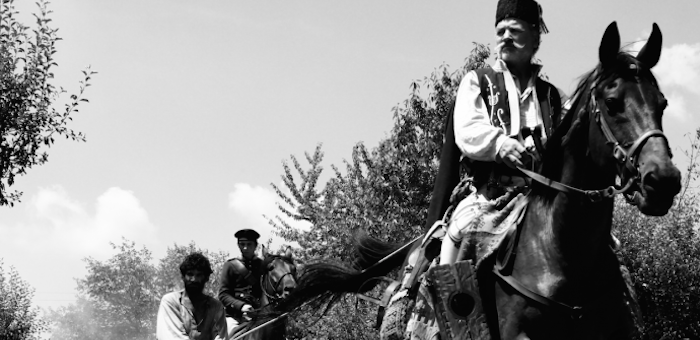 Vergine giurata (2015)
Vergine giurata (2015)
The Berlinale, as the Berlin International Film Festival is called, is one of the largest in the world. During the 10 days of the Berlinale, literally hundreds of films are screened in various sections, including the Competition, Forum, German Perspectives, Panorama, Generation, Retrospective and NATIVe—A Journey into Indigenous Cinema. It is impossible to see anything but a minute fragment of the films on display. I therefore decided to focus mostly on the Competition and the Retrospective during the four days I was there.
Arriving on Monday evening, halfway through the Festival, my viewing began the following morning at the Friedrichstadt-Palast in central Berlin, where the competition films are reprised after their opening screening, with the Chilean feature El Club [The Club] (2015), directed by Pablo Larrraín. The film opens on a dark and cloudy seascape in a small coastal town. A group of priests and a nun live together in a communal home, praying, working, ora et labora. During the course of the narrative, it becomes clear that these priests are all pedophiles who have been squirreled away in the provinces by the Catholic Church hierarchy. When a former victim appears in town, the group experiences turmoil, which not even a church investigator can alleviate. Tearing away at the Church’s façade of respectability, the film ruthlessly exposes the Catholic Church’s culpability in crimes against children. The film ended up winning the Silver Bear Grand Jury Prize, behind director Jafar Panahi’s Iranian feature Taxi.
 Nena (2014)
Nena (2014)
Next, I saw Nena (2014), a Dutch-German co-production, which ran in the Generation program (geared towards the youth). Directed by Saskia Diesing and starring Abbey Hoes, the film tells the story of a teenage girl on the Dutch-German border, who experiences her first sexual romance and must confront the reality of her paraplegic father, who is mortally ill and wants to commit suicide. This tough subject is handled with extreme sensitivity and without conventional sentimentality. The film won a Special Mention from the Generation jury, and the actress who played the lead won a prize for best new talent. Every year, I’m surprised by how many wonderful and serious films are made for children and teenagers in the rest of the world, none of which are ever shown in the United States, where the entertainment industry treats children like babies or morons.
Still on Tuesday, I made it to a Panorama screening of Jun Zhong le Yuan [Paradise in Service] (2014), a Taiwanese film directed by Doze Niu Chen-Zer and co-edited by Hou Hsiao-hsien. Taking place during the height of the Cold War, the film details the life of young Taiwanese men who are conscripted into Chiang-Kai-shek's army circa 1969 and sent to an island just off the coast of Mainland China, where the Nationalist and Red Chinese face off in an all-out propaganda war. A bit melodramatic and sentimental, despite the brutality of the Chinese NCOs, the film nevertheless presents an accurate portrait of those rabidly anti-Communist times.
 Aferim! (2015)
Aferim! (2015)
Thursday morning, I was back at the Competition to see the black and white epic Aferim! (2015), a Romanian-Bulgarian-Czech co-production directed by Radu Jude. Unfolding in the early 19th-century, a local gendarme and his son are seen chasing a runaway gypsy slave, who was caught sleeping with the nobleman’s wife. Structured like a Western, the film realistically details the harsh life of Turks, Russians, Christians, Jews, Romanians and Magyars in the backwaters of the Ottoman Empire, revealing prejudices, superstitions and an unsympathetic humanity. Jude won a Silver Bear for Best Director.
Second up was director Peter Greenaway's Eisenstein in Guanajuato (2014), which speculates about Russian director Sergei Eisenstein losing his virginity while shooting ¡Que Viva México! (1932) in the early 1930s. Indeed, there is no actual footage of Eisenstein directing his tragically aborted film, Greenaway preferring to visualize the director’s down time in his hotel, where he gets harassed by Upton Sinclair's wife, while playing with his Mexican boyfriend. Greenaway makes interesting use of split screens and footage intercut from Eisenstein's own films, but more daring is the extended frontal male nudity; it’s the first mainstream feature film I’ve ever seen with an erect penis front and center. The local Berlin audience took it in stride.
Eisenstein in Guanajuato (2014)
On Friday morning, I saw Vergine giurata [Sworn Virgin] (2015), an Albanian-Italian language film about Albanian émigrés in Italy, and the tradition-bound, patriarchal life they have left behind. Directed by Laura Bispuri, the film follows a so-called "sworn virgin," a woman in Albania who lives her life as a man in order to escape the status of virtual servitude accorded wives. In exchange for male privileges, these women eliminate all signs of gender and swear off sex of any kind, literally becoming "sons" to their fathers. Freed from traditional constraints, once in exile, the young wo(man) slowly discovers her sexuality. Utilizing a complex flashback structure, the film contrasts past and present, Albania and Italy, and mountains and cities.
My final viewing was Elser [13 Minutes] (2015), a German film by director Oliver Hirschbiegel. The film concerns an assassination attempt on Adolf Hitler in 1939, organized by a lone wolf named Georg Elser. The Nazis try unsuccessfully to turn the affair – which cost the lives of eight people – into a massive Communist conspiracy, but find no evidence. Elser survived in a concentration camp until April 1945, when he was murdered by the SS. His status as a resistance fighter was not recognized by the German government until decades after the war – not an uncommon occurrence, given that the Nazi German judiciary was never de-nazified, remaining on the bench for decades after the war. This film was a fitting tribute to those few Germans who did resist Nazi terror.
< Back to Archival Spaces blog






 Mobile Navigation
Mobile Navigation

